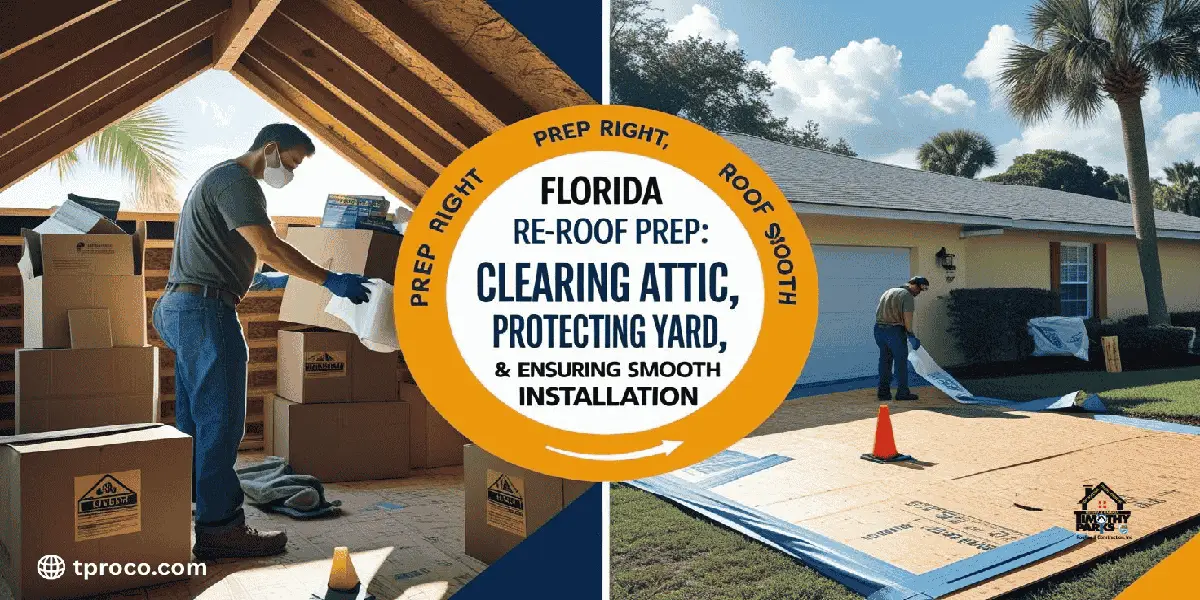Our Blogs
Florida Re-Roof Prep: Clearing Attic, Protecting Yard & Ensuring Smooth Installation 🚧
When it’s time for a Florida re-roof—whether from storm damage or age—preparing your home ahead of the crew’s arrival can save headaches (and broken plants). Think beyond just an empty driveway. You might need to clear your attic of stored items, protect fragile landscaping, or even coordinate with neighbors about debris. This blog outlines the best pre-install steps so you’re not scrambling when roofers show up with tear-off tools. From moving attic boxes to covering AC units, a bit of planning ensures your new roof goes on smoothly and your property remains unscathed in the process. Let’s walk through how to get everything set before the hammering starts, so you can avoid stray nails in your yard and keep your Florida home safe during the roof replacement.

1. Clearing & Protecting Your Attic
In Florida, many attics double as storage for holiday decor, old photo albums, or clothing boxes. During re-roofing:
- Dust & Debris Falls Through Deck Gaps: As the crew pries off old shingles or nails new materials, small chips or dust can sift into the attic. If your items are uncovered, they’ll get coated.
- Vibration & Movement: The deck flexes slightly when nails drive in. Delicate items could tip over if not secured.
- Moving or Covering Items: Ideally, remove valuables, electronics, or fragile boxes. If that’s not possible, drape plastic sheeting over everything to catch falling debris.
You might ask your Florida roofer if they plan to remove and replace any deck plywood, which can cause larger debris to fall inside. If so, be sure your attic is extra clear. A little attic prep spares you hours of dusting or discovering your treasured keepsakes got knocked around. Some local roofers also place a tarp from above if they see big cracks or open decking, but it’s simpler if you handle it from below first.
2. Yard & Landscaping Precautions
Roof tear-offs produce a lot of shingle debris, nails, and potential hazards:
Protect Shrubs & Flower Beds:
Tarps or plywood sheets can shield plants from falling nails or tile shards. Florida’s sun can wilt covered plants if left for days, so coordinate short-term coverage.
Move Lawn Furniture & Grills:
Shift them away from the house perimeter. If you can’t move heavy items, ask the crew to tarp them. Even a plastic chair can get scuffed or embedded with nails dropping from overhead.
Cordon Off Kid & Pet Areas:
Keep kids’ playsets or dog runs clear of roofing zones. Florida roof replacements can last a couple of days, with stray nails or tile bits inevitably hitting the ground.
Access & Dumpster Placement:
Many Florida roofers bring a trailer or dumpster. Make sure your driveway or a designated spot can accommodate it without crushing sprinklers or garden edges.
A quick yard walk with your roofer before they begin helps identify delicate spots: your prized rose bushes or an AC unit that’s easily dented. The crew may place plywood lean-to’s against walls or lay tarps to catch debris. By labeling or blocking off special landscaping, you avoid heartbreak if a shingle bundle drops exactly on your prized tropical hibiscus.
3. Scheduling & Communication with Neighbors
Florida subdivisions can be tight-knit or have strict HOA rules:
- Inform Neighbors about Noise & Debris: Let them know your roof is scheduled for certain dates, so they’re prepared for hammering or potential loose nails near property lines.
- HOA Notification: Some communities require an “architectural approval” or notice of roofing color changes. Submit the paperwork well in advance.
- Consider Local Ordinances: Some Florida counties limit early morning noise or weekend construction hours. Make sure your roofer abides by these rules.
A heads-up fosters good relations and might save you from neighbor complaints if the crew starts at 7 a.m. on a Saturday. Also, ensure your roofers park in an agreed spot, not blocking mailboxes or hydrants. Florida’s heat often means crews start at dawn to avoid midday scorching, so it’s best if neighbors understand the schedule so they’re not caught off guard.
4. Handling AC Units, Satellite Dishes & Utilities
Roof-mounted utilities or lines complicate the tear-off:
Satellite Dishes on the Roof:
Many older Florida homes have dishes bolted through shingles. During re-roof, they might remove or temporarily relocate the dish. Prepare for possible TV service interruption.
AC Lines & Vents:
Some Florida AC setups place lines or vent stacks near the roof edges. Confirm the roofer knows not to damage these. Marking them or giving them extra clearance is wise.
Solar Panels or Pool Heaters:
If you have rooftop solar or pool heating mats, these must be dismounted and reinstalled. Clarify if your roofing contractor handles it or if you need a solar specialist.
If you have cable lines or internet cables strapped to the eaves, unfasten them or inform the roofer so they don’t cut them by mistake. Re-roofing in Florida can be hectic, so labeling or pointing out these lines ensures the crew works around them carefully. If extra steps are needed (like removing a dish and reinstalling), factor that into your schedule and budget.
5. Post-Installation Cleanup & Final Checks
Once the roof is done, a few tasks finalize a smooth experience:
Nail & Debris Sweep:
Good Florida roofers run a magnetic roller over grass, flowerbeds, and driveways to pick up stray nails. Do a personal walk-around too, checking corners or behind shrubs.
Gutter Rinse or Reattach:
If gutters were removed or battered with shingle debris, ensure they’re reattached and flushed clean. Check for any new leaks at gutter seams.
Inspect Attic & Interiors:
Peek into the attic for any dust accumulation or leftover debris. Wipe surfaces or vacuum if needed. Also, check ceilings for fresh stains in case a flashing detail was missed.
Confirm Warranty & Code Sign-Off:
Florida re-roofs typically need final inspection by the county or city. Also keep your contractor’s workmanship warranty and manufacturer warranty docs on file.
A thorough cleanup prevents nails in car tires or a yard hazard for kids and pets. If you find leftover materials, discuss with the roofer if they want them back or if you’d like spares. Document the new roof with photos and keep your receipts—handy for insurance or future resale. Florida’s re-roof process might be loud and messy for a day or two, but these final touches restore order quickly.
Conclusion
Preparing for a Florida re-roof goes beyond clearing your driveway—it’s about safeguarding your attic items, covering cherished landscaping, and coordinating with neighbors and your contractor on noise and debris management. By removing attic valuables or draping them with plastic, you avoid dust-laden boxes; by tarping shrubs and yard furniture, you prevent accidental damage from falling shingles. Good communication ensures the crew knows about sensitive AC lines or satellite dishes. Once the last nail is hammered, a thorough cleanup and final inspection wrap it up neatly. With these steps, you’ll sail through re-roofing with minimal stress, emerging with a fresh, code-compliant roof ready for Florida’s storms—plus a yard and attic left unscathed.
Frequently Asked Questions (FAQ)
🚧 Getting a New Roof in Florida? Prep Smart to Protect Your Home!
Don’t wait until the crew shows up. From clearing your attic to shielding your landscaping, proper prep makes re-roofing smoother and safer for your property.
#tproco #tppro #tprci #urro #rrfl
#ReRoofPrep #FloridaInstallation #RoofReplacement #TampaHomeCare #OrlandoRoof #SunshineState
Schedule a Free InspectionAbout the Author

Timothy Parks
CEO
📢 Stay Informed: Communication & Consent Updates
At Timothy Parks Roofing & Construction Inc., we prioritize transparency in our communications. By submitting a request, you agree to receive calls, texts, and emails regarding our services. Standard messaging rates may apply. You can opt-out at any time by replying STOP or contacting us directly.
✅ Florida License: #CBCO59592, #CCC1327217, #HI4878
📌 Privacy & Terms: Read our Privacy Policy and Terms of Service.



